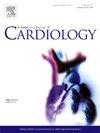The mobile health intervention for rural patients with atrial fibrillation a randomized controlled trial
IF 3.2
2区 医学
Q2 CARDIAC & CARDIOVASCULAR SYSTEMS
引用次数: 0
Abstract
Background
Rural individuals with atrial fibrillation (AF) experience challenges to anticoagulation adherence and self-management of the condition. We tested an intervention to improve anticoagulation adherence, quality of life, and health care utilization in rural individuals with AF.
Methods
We randomized rural patients with AF receiving anticoagulation to receive a smartphone-based relational agent (for disease education and adherence guidance) and a heart rate and rhythm monitor for 4 months or a smartphone-based health education app. Adherence was determined with 12-month proportion of days covered (PDC), and secondary outcomes of quality of life and health care utilization from interviews and health records.
Results
The trial randomized 270 individuals 1:1 (median [IQR] age 73.1 [67.5–78.6]; 163 [60.4 %] female sex). Over the 4-month intervention, intervention participants used the relational agent a median of 101 (IQR: 72, 110) days. In an intention-to-treat analysis there was no significant difference in 12-month PDC between the intervention and control groups (median [IQR]: intervention 0.97 [0.89–1.00] versus control 0.97 [0.92–1.00]) or in PDC ≥0.80. Intervention participants were more likely to self-report anticoagulation adherence than control at 4 and 8 months (95.7 % vs 88.4 % and 93.0 % vs 78.8 %, respectively) but not at 12 months. There were no significant differences by assigned intervention for the other secondary outcomes.
Conclusions
Randomization to the relational agent intervention was not associated with improved PDC at 12-months but with greater interim self-reported adherence compared to a control. This study demonstrates the successful use of a smartphone-based agent to address adherence among rural individuals with AF.
农村房颤患者流动卫生干预的随机对照试验
农村心房颤动(AF)患者在抗凝依从性和病情自我管理方面面临挑战。我们测试了一种改善农村房颤患者抗凝依从性、生活质量和医疗保健利用的干预措施。方法我们将接受抗凝治疗的农村房颤患者随机分组,接受基于智能手机的相关药物(用于疾病教育和依从性指导)和心率和节律监测仪,为期4个月或基于智能手机的健康教育应用程序。从访谈和健康记录中获得生活质量和医疗保健利用的次要结果。结果270例患者按1:1随机分组(中位[IQR]年龄73.1 [67.5-78.6];163[60.4%]女性)。在4个月的干预中,干预参与者使用关系代理的中位数为101天(IQR: 72, 110)。在意向治疗分析中,干预组和对照组12个月的PDC无显著差异(中位数[IQR]:干预组0.97[0.89-1.00]对对照组0.97[0.92-1.00])或PDC≥0.80。干预参与者在4个月和8个月时比对照组更有可能自我报告抗凝依从性(分别为95.7%对88.4%和93.0%对78.8%),但在12个月时则不是这样。其他次要结果在指定干预方面没有显著差异。结论:随机化相关药物干预与12个月时PDC的改善无关,但与对照组相比,中期自我报告的依从性更高。这项研究证明了基于智能手机的药物在解决农村房颤患者依从性方面的成功应用。
本文章由计算机程序翻译,如有差异,请以英文原文为准。
求助全文
约1分钟内获得全文
求助全文
来源期刊

International journal of cardiology
医学-心血管系统
CiteScore
6.80
自引率
5.70%
发文量
758
审稿时长
44 days
期刊介绍:
The International Journal of Cardiology is devoted to cardiology in the broadest sense. Both basic research and clinical papers can be submitted. The journal serves the interest of both practicing clinicians and researchers.
In addition to original papers, we are launching a range of new manuscript types, including Consensus and Position Papers, Systematic Reviews, Meta-analyses, and Short communications. Case reports are no longer acceptable. Controversial techniques, issues on health policy and social medicine are discussed and serve as useful tools for encouraging debate.
 求助内容:
求助内容: 应助结果提醒方式:
应助结果提醒方式:


